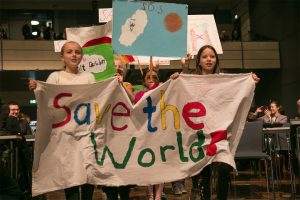23 April 2018: The UNFCCC Secretariat has prepared a note presenting an overview of inputs submitted by Parties and non-Party stakeholders to the Talanoa Dialogue. The note describes the general trends and contents of inputs, categorized according to the three questions of the Talanoa Dialogue: Where are we? Where do we want to go? How do we get there?
The note, which synthesizes inputs received before 2 April 2018, is intended to facilitate Talanoa Dialogue discussions that will take place in parallel with the UN Climate Change Conference in Bonn, Germany, from 30 April to 10 May. The overview will be updated prior to the 24th session of the Conference of the Parties (COP 24) to the UNFCCC, convening in Katowice, Poland, from 3-14 December, to capture inputs submitted by 29 October.
A total of 220 inputs met the 2 April deadline and were uploaded to the Talanoa Dialogue platform. Some answer all three questions, while others answer only one or two. 49 Parties submitted 15 inputs, including seven individual Parties and eight groups of Parties. The rest of the inputs are from non-Party stakeholders, including civil society, academia, research organizations, the private sector, subnational governments, international organizations and UN bodies.
Many inputs call for development paths that are just, inclusive, and consistent with human rights and equity.
Most of the inputs call for “wider and deeper” collaboration and partnerships, and say that the scale and pace of climate action must increase “dramatically and immediately” at the international, national and subnational levels. At the international level, inputs reflect the need for, inter alia, more ambitious and robust Nationally Determined Contributions (NDCs) by 2020, delivering on pre-2020 actions and a strong rule book for the Paris Agreement on climate change. At the national and subnational levels, inputs underscore the need to establish legal, policy, regulatory, fiscal, governance and investment frameworks to remove barriers, create incentives and mobilize broad action. Finance is a recurrent issue across all three questions, focusing on assessments of current finance levels or estimates of what is required to meet climate goals.
Many inputs refer to the moral dimension of climate change, and call for transitions and development paths that are just and inclusive, and consistent with human rights and equity. Some point to consequences from failing to fully apply the polluter-pays principle, and the benefits of policies like carbon pricing and phasing out perverse subsidies.
Highlighting synergies between climate action and sustainable development, inputs discuss links between meeting the goals of the Paris Agreement and the SDGs. On resilience and adaptation, inputs highlight links between the Paris Agreement’s goals and those of the Sendai Framework for Disaster Risk Reduction (DRR).
A total of 107 inputs address the first question (Where are we?), describing findings on greenhouse gases (GHGs) at the global, national or sectoral scale, setting out the state of play on climate impacts and vulnerability, showcasing initiatives and actions, and analyzing existing institutional arrangements.
A total of 114 inputs address the second question (Where do we want to go?), identifying aspirations in terms of global goals and principles for climate action, outlining emissions scenarios and trajectories compatible with goals, describing a future vision towards a zero-emissions world and climate resilience, outlining the stakeholders’ vision and ambition for themselves; and setting out expectations regarding future institutional arrangements.
A total of 148 inputs address the third question (How do we get there?), showcasing existing action on the ground that is achieving results and may be replicated and/or scaled-up, sharing knowledge on high-potential solutions, including technologies and collaboration models that may help accelerate climate action, and making recommendations for the UNFCCC Secretariat and the Convention bodies on issues to be addressed in international climate negotiations. They also make recommendations for national government action to ensure progress towards achieving the vision and ambition outlined in question 2, and for the private sector and intergovernmental organizations.
The May Talanoa Dialogue arrangements include an opening meeting on 2 May, in-depth discussion of the three questions on 6 May, a report-back meeting on 8 May and a closing meeting on 9 May. [Overview of Inputs to Talanoa Dialogue] [Talanoa Dialogue Presidencies Webpage] [SDG Knowledge Hub Story on Parties Providing Inputs to Talanoa Dialogue] [SDG Knowledge Hub Story on Non-Party Stakeholders Providing Inputs to Talanoa Dialogue]


